ADULT EDUCATION
Paper – II
Note : This paper contains fifty (50) objective type questions of two (2) marks each. All questions are compulsory.
1. What is not the cause of frustration for an adolescent of the following ?
(1) Delay in getting job
(2) Delay in getting marriage
(3) Delay in getting prestige
(4) Delay in getting maturity
2. ‘The Right to Education’ was first recognised as a human right by
(1) United Nation Universal Declaration of human rights
(2) Indian Constitution
(3) SAARC Summit
(4) Millennium Development Goals
3. Which of the following statements is not true ?
(1) One third of Indian population is below poverty line.
(2) India has been declared a polio free nation.
(3) One third of female population of India is still illiterate.
(4) The Gujarat state has the highest literacy rate in the country.
4. Who among the following was associated with “Etawah Pilot Project” ?
(1) Albert Mayer
(2) W.H. Wisher
(3) R.N. Tagore
(4) F.L. Browne
5. To achieve a “stable population” by 2045 is one of the
(1) “Immediate objective” of India’s population policy.
(2) “Medium term objective” of India’s population policy.
(3) “Long term objective” of India’s population policy.
(4) “Decadal objective” of India’s population policy.
6. The main objective of “National Adult Education Programme” launched in 1978 was
(1) Literacy alone
(2) Social awareness alone
(3) Functionality alone
(4) Literacy, functionality and social awareness
7. The book entitled ‘Pedagogy of the Oppressed’ is written by
(1) Paulo Freire
(2) S. Waghmare, V. Waghmare
(3) R.N. Tagore
(4) Paterson
8. “Reflection without Action is mere verbalism, action without reflection is pure activism” Who made the above statement ?
(1) McKenzie
(2) Knowles
(3) Freire
(4) Goodman
9. Which of the following is not required for bare survival of life ?
(1) Food
(2) Water
(3) Fashion
(4) Protection of life
10. Arrange the stages of communication in order these are practised. Use the codes given below :
a. Feedback b. Decoding
c. Content d. Encoding
Codes :
(1) c, d, b, a
(2) c, b, a, d
(3) c, d, a, b
(4) a, b, c, d
11. Arrange the following major literacy programmes of different countries in order these were introduced. Use the codes given below :
a. India b. Vietnam
c. Myanmar d. Cuba
Codes :
(1) b, d, c, a
(2) a, b, c, d
(3) d, c, b, a
(4) b, a, c, d
12. Arrange the following institutions as these were incorporated. Use the codes given below :
a. Bengal Social Service League
b. Rural Reconstruction Centre Sriniketan
c. Indian Adult Education Association
d. Indian University Association for Continuing Education
Codes :
(1) a, b, c, d
(2) b, a, d, c
(3) b, a, c, d
(4) d, a, c, b
13. Arrange the following programmes in order these were introduced. Use the codes given below :
a. Community Development Programme
b. Mahila Samakhya
c. Integrated Rural Development Programme
d. Jandhan
Codes :
(1) a, b, c, d
(2) b, c, a, d
(3) a, c, b, d
(4) c, a, b, d
14. Arrange the following steps of Literacy Programme in order of their use. Use the codes given below :
a. Certification of the learners
b. Instruction for the learners
c. Identification of learners
d. Motivation among the learners
Codes :
(1) b, c, a, d
(2) c, d, b, a
(3) a, b, c, d
(4) d, b, a, c
15. Arrange the following programmes of adult education in order these were conducted. Use the codes given below :
a. Sakshar Bharat
b. Total Literacy Campaign
c. Gram Shikshan Muhim
d. National Adult Education Programme
Codes :
(1) a, b, c, d
(2) b, d, a, c
(3) c, d, b, a
(4) a, b, d, c
16. Arrange the stages/functions of management as these are applied in conduct of a programme. Use the codes given below :
a. Provisioning of resources b. Preparing a blue-print
c. Information system d. Corrective mechanism
Codes :
(1) a, b, c, d
(2) b, a, c, d
(3) a, c, d, b
(4) d, b, a, c
17. Arrange the following institutions in order of their establishment for promotion of continuing education. Use the codes given below :
a. Jan Shikshan Nilayam
b. Shramik Vidya Peeth
c. Krishi Vigyan Kendra
d. Lok Shikshan Kendra
Codes :
(1) a, c, d, b
(2) b, d, a, c
(3) c, b, a, d
(4) b, c, a, d
18. Arrange the stages of evaluation of social development programme as per their sequence in adoption. Use the codes given below :
a. Development of instruments
b. Analysis
c. Determining the parameters
d. Administering the tools
Codes :
(1) a, b, c, d
(2) b, c, d, a
(3) c, d, a, b
(4) c, a, d, b
19. Arrange the training of functionaries in adult education in order these were imparted. Use the codes given below :
a. Training of volunteers
b. Training of resource persons
c. Training of master trainers
d. Training of key resource persons
Codes :
(1) a, b, c, d
(2) d, c, b, a
(3) c, d, b, a
(4) c, a, d, b
20. Arrange the following needs as per the Hierarchical Theory of Needs using the codes given below :
a. Self-esteem needs b. Security needs
c. Basic needs d. Self-actualisation needs
Codes :
(1) c, b, a, d
(2) c, d, b, a
(3) c, a, b, d
(4) c, d, a, b
21. Arrange the following milestones in chronological order. Use the codes given below :
a. Sarva Shiksha Abhiyan
b. Sakshar Bharat
c. Right to education to children of 6-14 years
d. Right to Information
Codes :
(1) a, d, b, c
(2) b, a, d, c
(3) a, c, b, d
(4) a, b, c, d
22. Assertion (A) : An oral message is more dynamic and makes direct impact than a written message.
Reason (R) : An oral message is always better than a written message.
Codes :
(1) (A) is correct and (R) is wrong.
(2) (R) is correct and (A) is wrong.
(3) Both (A) and (R) are wrong.
(4) Both (A) and (R) are correct.
23. Assertion (A) : “Family Life Education” is a part of the population education programme.
Reason (R) : Family Life Education contributes to the emergence of a small family.
Codes :
(1) (A) is correct and (R) is the outcome of (A).
(2) Both (A) and (R) are wrong.
(3) (A) is correct and (R) is wrong.
(4) (R) is correct and (A) is wrong.
24. Assertion (A) : The percentage growth of education among girls and women has contributed to their empowerment.
Reason (R) : The increase in the education of girls does not contribute to postponement of the age of marriage and to a reduction in the size of families.
Codes :
(1) Both (A) and (R) are correct.
(2) Both (A) and (R) are wrong.
(3) (A) is correct and (R) is wrong.
(4) (R) is correct and (A) is wrong.
25. Assertion (A) : One of the greatest attributes of a successful leader is the ability to communicate simply and effectively.
Reason (R) : Knowledge alone is adequate for a successful leader.
Codes :
(1) (A) is correct and (R) is wrong.
(2) (R) is correct and (A) is wrong.
(3) Both (A) and (R) are correct.
(4) Both (A) and (R) are wrong.
26. Assertion (A) : Human senses are the gateways to learning.
Reason (R) : Learning activities should engage maximum number of senses by using audiovisual aids.
Codes :
(1) (A) is correct and (R) is wrong.
(2) (R) is correct and (A) is wrong.
(3) Both (A) and (R) are correct and (R) is correct explanation of (A).
(4) Both (A) and (R) are correct, but (R) is not the correct explanation of (A).
27. Assertion (A) : India has experienced a drastic rise in educational level among its population in the past three decades.
Reason (R) : The differences in educational attainment between males and females have shrunk.
Codes :
(1) (A) is correct and (R) is wrong.
(2) Both (A) and (R) are correct and (R) is correct explanation of (A).
(3) (R) is correct and (A) is wrong.
(4) Both (A) and (R) are correct, but (R) is not the correct explanation of (A).
28. Match the items given in List – I with the items of List – II, use the codes given below :
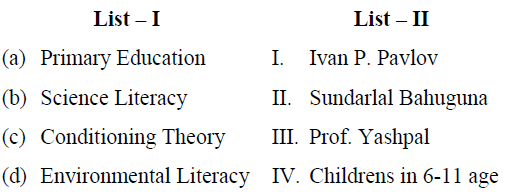
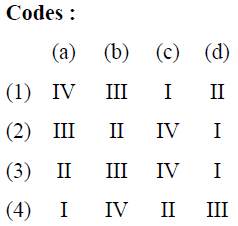
29. Match the items given in List – I with the items of List – II, use the codes given below :
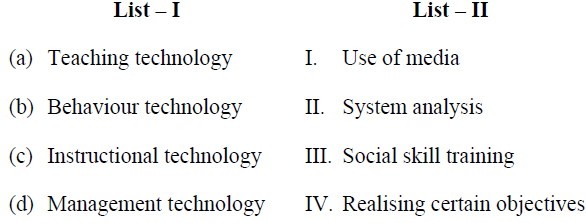
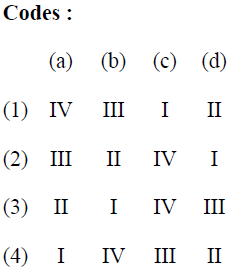
30. Match the items given in List – I with the items of List – II, use the codes given below :

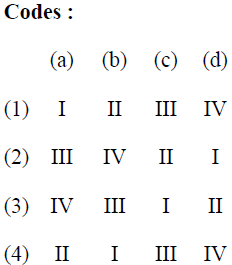
31. Match the items given in List – I with the List – II, use the codes given below :
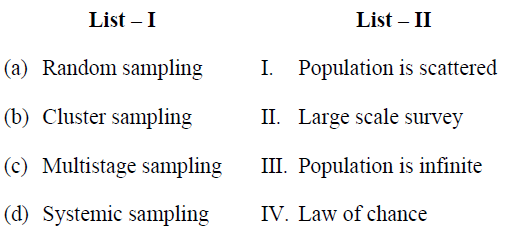
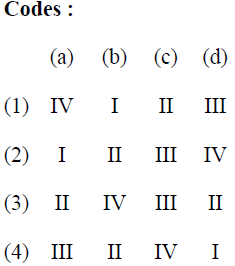
32. Match the items given in List – I with the items of List – II, use the codes given below :

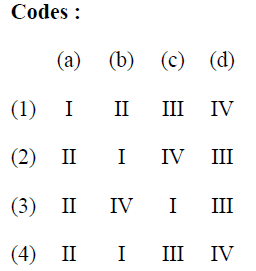
33. Match the items given in List – I with the items in List – II, use the codes given below :

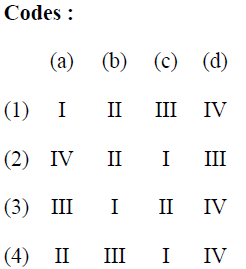
34. Match the items given in List – I with the items in List – II, use the codes given below :
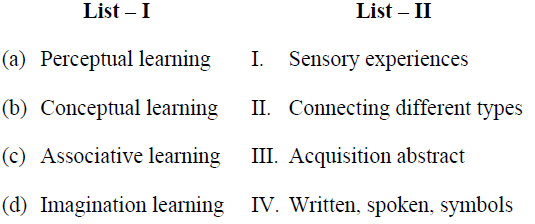
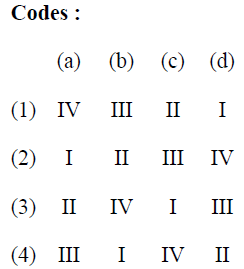
35. Match the items given in List – I with the items in List – II, use the codes given below :

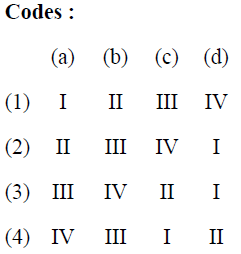
36. Which of the following are the most important means of empowering women ?
Use the codes given below :
(a) Literacy and Education
(b) Health and Nutrition
(c) Free travel Facilities
(d) Freedom to Worship
Codes :
(1) (a) and (b)
(2) (b) and (c)
(3) (c) and (d)
(4) (a) and (d)
37. Which of the following is an example of formal institution ? Use the codes given below :
(a) School (b) Crowd
(c) Panchayat (d) Self help group
Codes :
(1) (a) and (b)
(2) (b) and (c)
(3) (a), (c) and(d)
(4) (b), (c) and (d)
38. Which of the following are the constituents of education ? Use the codes given below :
(a) Teacher and learner
(b) Furniture
(c) Methods and contents
(d) Goals and objectives
Codes :
(1) (a), (b) and (c)
(2) (b), (c) and (d)
(3) (a), (b) and (d)
(4) (a), (c) and (d)
39. Which of the following is an agent of positive social change ? Use the codes given below :
(a) Education (b) Economic development
(c) Innovation (d) Calamity
Codes :
(1) (b), (c) and (d)
(2) (c) and (d)
(3) (a), (b) and (c)
(4) (a) and (d)
40. “Factors” concerning adult learners are important guideposts for development and formulation of a typology of adult learners.
(a) Socio-cultural (b) Socio-economic
(c) Psycho-social (d) Trends of fashion
Codes :
(1) (a), (b) and (c)
(2) (b) and (c) only
(3) (a), (b) and (d)
(4) Above all
41. Education is a process of bringing about desirable changes in human-being
(a) Skills (b) Knowledge
(c) Attitude (d) Gambling
Codes :
(1) (a) and (d)
(2) (b), (c) and (d)
(3) (c) and (d)
(4) (a), (b) and (c)
42. Communication is the process by which two or more persons exchange _____.
(a) Ideas
(b) Facts
(c) Feelings
(d) Power
Codes :
(1) (a) and (d)
(2) (a), (b) and (c)
(3) (b), (c) and (d)
(4) (c) and (d)
43. The Experimental World Literacy Programme (EWLP) was promoted during 1965 to 1975 by
(a) UNICEF (United Nations International Children Emergency Fund)
(b) UNESCO (United Nations Educational, Scientific and Cultural Organisation)
(c) W.H.O. (World Health Organisation)
(d) UNDP (United Nations Development Programme)Codes :
(1) (a) only
(2) (a) and (b)
(3) (b) and (d)
(4) (a), (b) and (d)
44. In the universities, the Population Education Resource Centre (PERC) scheme was implemented by
(a) United Nations Population Fund
(b) University Grants Commission
(c) National Council of Education Research and Training
(d) Department of Adult and Continuing Education of Universities
Codes :
(1) (a) and (d)
(2) (b) and (d)
(3) (c) and (d)
(4) (a), (b) and (d)
45. The main consequences of overpopulation are : Use the codes given below :
(a) Deforestation due to need for more houses.
(b) Loss of ecosystem
(c) High life expectancy
(d) High infant and child mortality
Codes :
(1) (a), (b) and (d)
(2) (a) and (c)
(3) (b), (c) and (d)
(4) (c) and (d)
Direction : (Q. No. 46 to 50) :
Comparative education is a fully established academic field of study that examines education in one country (or group of countries) by using data and insights drawn from the practices and situation in another country, or countries. Programmes and courses in comparative education are offered in many universities throughout the world, and relevant studies are regularly published in scholarly journals. The field of comparative education is supported by many projects associated with UNESCO and the national education ministries of various
nations.
Comparative education has four purposes :
1. To describe educational systems, processes or outcomes.
2. To assist in the development of educational institutions and practices.
3. To highlight the relationship between education and society.
4. To establish generalized statements about education that are valid in more than one country.
Many important educational questions can best be examined from an international and comparative perspective. For example, in the United States there is no nationwide certificate of completion of secondary education. This raises the question of what the advantages and disadvantages are of leaving such certification to each of the 50 states. Comparative education draws on the experience of countries such as Japan and France to show how a centralized system works, and what are the advantages and disadvantages of centralised certification.
46. Comparative education is a study based on
(1) evaluation of one system in one country with the same system in another country.
(2) description of many systems in the same country.
(3) the economics of fashion industry in two countries.
(4) the dietary preferences in one country.
47. Projects in comparative education are financed by
(1) only by business corporations in various nations.
(2) only UNESCO
(3) only education ministries of various nations.
(4) Both UNESCO and ministries of education in various nations.
48. The purpose of comparative education helps to make generalised statements that are valid
(1) in more than one dissertation
(2) in more than one country
(3) in more than one play field
(4) in one coaching shop
49. Japan has a _______ system whereas France has a _______ system of certification of students.
(1) decentralized – centralized
(2) centralized – centralized
(3) centralized – decentralized
(4) decentralized – decentralized
50. A centralized system of certification has _______.
(1) only advantages
(2) only disadvantages
(3) both advantages and disadvantages
(4) more advantages and less disadvantages
Latest Govt Job & Exam Updates: